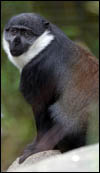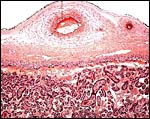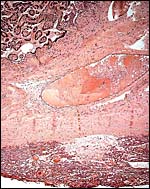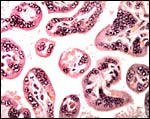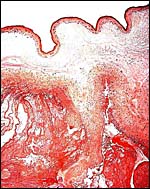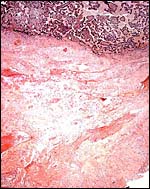| (Clicking
on the thumbnail images will launch a new window and a larger version
of the thumbnail.) |
| Last updated: April 18, 2007. |
L’hoest’s Guenon
Cercopithecus lhoesti
Order: Primates
Family: Cercopithecidae
1) General Zoological Data
This species is one of the more colorful primates of Africa and numerous sites that describe this animal and its habits can be retrieved from Google. They come from Zaire, Rwanda, Uganda and Burundi, are endangered from human interference (farming, see Lwanga, 2006) and have a maximal life expectancy in captivity of around 24 or more years (Weigl, 2005). Groves (2001) lists also C. thomasi as being a member of this group of “Meerkatzen” (as they are designated in German). A new [sub-]species (C. lhoesti solatus) has recently been described from Gabon (see Peignot et al., 1999; Brugier et al., 1998). Sleeper (1997) reported that these monkeys live in groups of 5-25 animals, depending on dietary availability, and that they flee on the ground, making it a more terrestrial species. Males (6 kg) are larger than females (3.5 kg). They live in female-dominated groups with a single male and eat fruit, leaves and insects, even small lizards (Tashiro, 2006).
The specimens available to me came from the San Diego Zoo; one is of a stillborn animal, the other a term delivery. An evolutionary tree based on modern genetic studies has been published by Xing et al. (2007); it suggests that this species is significantly different from many other guenons.
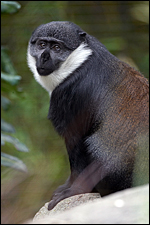 |
Cercopithecus lhoesti from the San Diego Zoo. |
2) General Gestational Data
Single births are the usual manner of reproduction, occurring after a gestation of approximately 5 months. The stillborn neonate here described weighed 457 g but no weight was obtained on the live-born fetus.
3) Implantation
No data exist at this time on the locus and timing of implantation; they would be highly desirable, especially to better understand the absence of atrophying villi in the membranes.
4) General Characterization of the Placenta
Two placentas were available of this species. One was a single-disked hemochorial placenta from a stillborn female term infant delivered at the San Diego Zoo that was still attached to the placenta. It weighed 77.6 g and the stillborn infant weighed 457 g. It was a single lobe that had a centrally inserted 31 cm long cord and some retroplacental clot was present, perhaps related to the stillbirth. The presence of only one lobe contrasts with many other cercopithecidae that have a two-lobed placenta. This one lobe measured 6.7 x 9 x 1 cm in dimensions. The fetal demise appears to have occurred during prolonged labor, as no anomalies were detected. The fetus had a 19 cm CR length and 19 cm long tail. The second placenta comes from a term live fetus and it had two disks, weighed 120.3 g and had a 24 x 0.3 cm long cord that was eccentrically inserted on one lobe. The disks measured 8 x 5 x 1.3 and 8 x 8 x 1.3 cm respectively.
 |
|
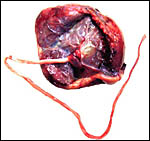 |
Appearance of the single-disked term placenta from the stillborn fetus. |
5) Details of fetal/maternal barrier
This is a typical hemochorial placenta. The villi are quite small and, at term, cytotrophoblast is no longer apparent; there is much syncytiotrophoblast however and, rarely, one encounters a ‘knot’ that presumably floats in the intervillous space. Hofbauer cells (macrophages) are present in the villous stroma. The chorion carries the fetal blood vessels and, on its under side, it has a single layer of extravillous trophoblast. Many macrophages can be found in the chorion and amnion. Rather large islands of extravillous trophoblast (“X-cells”) can be found especially at the site of implantation. Contrary to what is seen in most human placentas, however, these deposits did not produce cysts.
6) Umbilical cord
The umbilical cord of the stillborn fetus measured 31 x 0.4 cm and had virtually no twists. There were three vessels and neither ducts nor caruncles. The cord of the live term fetus was 24 x 0.3 cm.
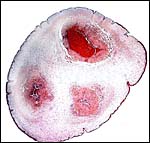 |
Term umbilical cord with 2 arteries and 1 vein. |
7) Uteroplacental circulation
No such studies have been conducted.
8) Extraplacental membranes
There is an extensive decidua capsularis but, as in other cercopithecids, there are no atrophying villi as exist in human placentas. There are large connecting blood vessels carried in the chorion between the two disks. Beneath the chorionic fibrous membrane is a layer of rather vacuolated extravillous trophoblast.
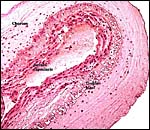 |
Free membranes with decidua capsularis that lack old villi and vacuolated trophoblast layer beneath chorion. |
9) Trophoblast external to barrier
No deep invasion of trophoblast is known to occur although there is apparent decidual infiltration by extravillous trophoblast.
10) Endometrium
There is a decidua basalis present and it is infiltrated by extravillous trophoblast. There is also some fibrinoid degeneration in this decidua basalis, more so at the margins of the disks.
11) Various features
This is unknown, absent an implanted placenta.
12) Endocrinology
I am not aware of any specific studies.
13) Genetics
This species has 60 chromosomes but there is also some confusion in the literature. The karyotypes with 72 chromosomes (having 22 acrocentric elements) reported by Chu & Bender (1961) and Egozcue (1969) must be in error. Thus, already M.J.D. White (1973) reported Hoest’s guenon to have 2n=58 or 60 (but how the 2n=58 was derived is unclear from the text), despite the fact that later in the same volume 2n=72 is reported for this species. At CRES of the San Diego Zoological Society, 3.5 animals have since been karyotyped and all had 2n=60, as was reported by O’Brien et al. (2006).
Gray (1972) reported that viable hybrids with Cercopithecus hamlyni have been produced in New York. Tosi et al. (2003, 2004) surveyed 20 guenons (Cercopithecini) for Y- and X-chromosomal genes and suggested that terrestriality took place only once in this group of arboreal animals. They also want to resurrect the genus Chlorocebus as the result of their studies. A more specific phylogeny has since been published from the same group (Xing et al., 2007).
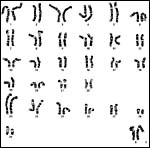 |
Typical karyotype of female L’Hoest’s guenon (see O’Brien et al., 2006). |
14) Immunology
No studies other than the virological investigations reviewed below are known to me.
15) Pathological features
There may be overlaps with the features seen in Kolb’s monkeys (see that chapter under ‘guenons’), but l’hoest’s monkeys also have major differences, genetically and in part also in their placentation. Various nematodes (Strongyloid species) and protozoa were identified in four guenon species by Gillespie et al. (2004). Infection with a simian immunodeficiency virus has been reported in an animal from an American zoo, but freshly imported (Beer et al., 1999). Its characterization was furthered by a new study of bloods from 14 animals in the Congo. Eight were found to be sero-positive (Beer et al., 2000). It appears to be related to the Papioni tribe SIV (mandrills) and the widespread infection was studied by Souquiere et al. (2001). Whether it actually causes disease in the monkeys is not clear.
Most cercopithecids have some small areas of infarction at the edges of their placental lobes, and that was seen in these two specimens. It was rather more marked in the single-disked stillborn’s placenta and there was an area of abruptio placentae with overlying infarct. The maternal vessels in the decidua basalis and capsularis, however, were normal. In addition, much degenerated old clot and fibrin was found behind its membranes.
16) Physiologic data
No studies are known to me.
17) Other resources
Fibroblast cell strains are available from CRES at the San Diego Zoo by contacting Dr. O. Ryder at oryder@ucsd.edu.
18) Other remarks – What additional Information is needed?
Early stages of implantation are needed, as are additional data from implanted placentas. We also await keenly a karyotype of C. l. solatus.
Acknowledgement
The animal photograph in this chapter comes from the Zoological Society of San Diego.
References
Beer, B.E., Bailes, E., Goeken, R., Dapolito, G., Coulibaly, C., Norley, S.G., Kurth, R., Gautier, J.P., Gautier-Hion, A., Vallet, D., Sharp, P.M. and Hirsch, V.M.: Simian immunodeficiency virus (SIV) from sun-tailed monkeys (Cercopithecus solatus): evidence for host-dependent evolution of SIV within the C. lhoesti superspecies. J. Virol. 73:7734-7744, 1999.
Beer, B.E., Bailes, E., Dapolito, G., Campbell, B.J., Goeken, R.M., Axthelm, M.K., Markham, P.D., Bernard, J., Zagury, D., Franchini, G., Sharp, P.M. and Hirsch, V.M.: Patterns of genomic sequence diversity among their simian immunodeficiency viruses suggest that L’Hoest monkeys (Cercopithecus lhoesti) are a natural lentivirus reservoir. J. Virol. 74:3892-3898, 2000.
Brugiere, D., Gautier, J. and Lahm, S.: Additional data on the distribution of Cercopithecus (lhoesti) solatus. Folia Primatol. 69:331-336, 1998.
Chu, E.H.Y. and Bender, M.A.: Chromosome cytology and evolution in primates. Science 133:1399, 1961.
Egozcue, J.: Primates. In, Benirschke, K.: Comparative Mammalian Cytogenetics. Pp. 357-389, Springer Verlag, NY, 1969.
Gillespie, T.R., Greiner, E.C. and Chapman, C.A.: Gastrointestinal parasites of the guenons of western Uganda. J. Parasitol. 90:1356-1360, 2004.
Gray, A.P.: Mammalian Hybrids. A Check-list with Bibliography. 2nd edition.
Commonwealth Agricultural Bureaux Farnham Royal, Slough, England, 1972.
Groves, C.: Primate Taxonomy. Smithsonian Institution., Washington, 2001.
Sleeper, B.: The amazing world of lemurs, monkeys and apes. Primates. Chronicle Books, San Francisco,1997.
Lwanga, J.S.: Spatial distribution of primates in a mosaic of colonizing and old growth forest at Ngogo, Kibale National Park, Uganda. Primates 47:230-238, 2006.
O’Brien, S.J., Menninger, J.C. and Nash, W.G., eds.: Atlas of Mammalian Chromosomes. Wiley-Liss; A. John Wiley & Sons, Inc. Hoboken, N.J., 2006.
Peignot, P., Fontaine, B. and Wickings, E.J.: Habitat exploitation, diet and some data on reproductive behaviour in a semi-free-ranging colony of Cercopithecus lhoesti solatus, a guenon species recently discovered in Gabon. Folia Primatol. 70:29-36, 1999.
Souquiere, S., Bibollet-Ruche, F., Robertson, D.L., Makuwa, M., Apetrei, C., Onanga, R., Kornfeld, C., Plantier, J.C., Gao, F., Abernethy, K., White, L.J., Karesh, W., Telfer, P., Wickings, E.J., Mauclere, P., Marx, P.A., Barre-Sinoussi, F., Hahn, B.H., Muller-Trutwin, M.C. and Simon, F.: Wild Mandrillus sphinx are carriers of two types of lentivirus. J. Virol. 75:7086-7096, 2001.
Tashiro, Y.: Frequent insectivory by two guenons (Cercopithecus lhoesti and Cercopithecus mitis) in the Kalinzu Forest, Uganda. Primates 47:170-173, 2005.
Tosi, A.J., Disotell, T.R., Morales, J.C. and Melnick, D.J.: Cercopithecine Y-chromosome data provide a test of competing morphological evolutionary hypotheses. Mol. Phylogenet. Evol. 27:510-521, 2003.
Tosi, A.J., Melnick, D.J. and Disotell, T.R.: Sex chromosome phylogenetics indicate a single transition to terrestriality in the guenons (tribe Cercopithecini). J. Hum. Evol. 46:223-237, 2004.
Weigl, R.: Longevity of Mammals in Captivity; From the Living Collections of the World. [Kleine Senckenberg-Reihe 48]. E. Schweizerbart’sche Verlagsbuchhandlung (Nägele und Obermiller), Stuttgart, 2005.
White, M.J.D. Chromosomal rearrangements in mammalian population polymorphism and speciation. In: Cytotaxonomy and Vertebrate Evolution. A.B. Chiarelli and E. Capanna, eds. Pp.95-128. Academic Press, London and New York, 1973.
Xing, J., Wang, H., Zhang, Y., Ray, D.A., Tosi, A.J., Disotell, T.R. and Batzer, M.A.: A mobile element-based evolutionary history of guenons (tribe Cercopithecini). BMC Biol. Jan. 31, 5:5, 2007.
